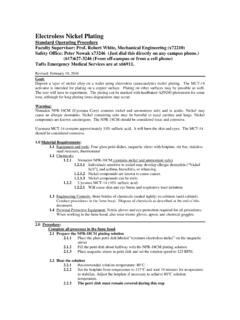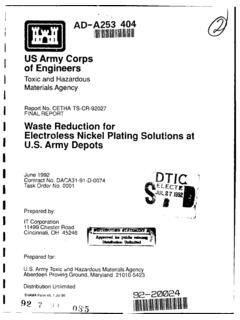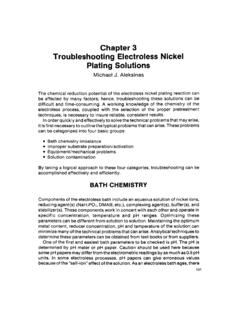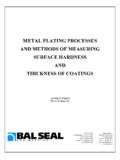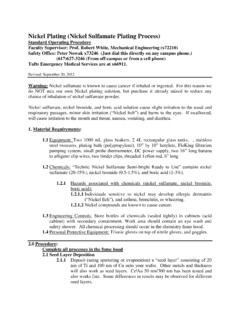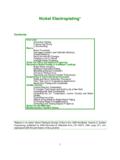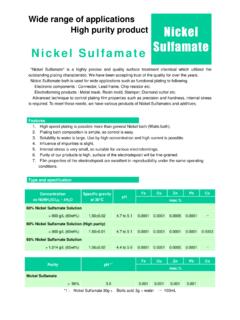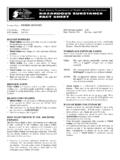Transcription of Complex Chemistry & the Electroless Copper Plating Process
1 2 Pl a t i n g & S u r f a c e Fi n i s h i n g Fe b r u a r y 2 0 0 4 Technical ArticleNuts & Bolts:What This Paper Means to YouIn Electroless Copper Plating , there is always a tug-of-war between the deposition rate and bath stability. A stable bath is slow, but a higher rate bath can decompose at the drop of a hat. Here, the authors have studied the effects of a dual-complexed Electroless Copper bath, using both EDTA and triethanolamine (TEA). The results show a successful a t i n g & S u r f a c e Fi n i s h i n g Fe b r u a r y 2 0 0 4 3 The effects of ethylenediaminetetraacetic acid (EDTA) and triethanolamine (TEA) as complexing agents on the electrochemical reduction of cupric ions and the oxidation of formaldehyde on palladium and Copper electrodes have been investigated. A dual-complexing agent Electroless Copper solution containing EDTA and TEA has also been investigated.
2 The reductive behavior of cupric ions in a strong base depends on the complexing agents because of the formation con-stant of the Complex , which affects the mixed poten-tial and thus the deposition rate of Electroless Copper . At the mixed potential, the oxidation of formaldehyde is independent of the Copper complexing agents, but can be accelerated by increasing the pH of the bath. The EDTA-based Electroless Copper solution has a relatively low deposition rate and high bath stability because EDTA forms a strong Complex with cupric ions. TEA adsorbs on palladium and can poison the oxidation of formaldehyde and thus inhibit the initial Copper deposition on the active palladium. Although TEA forms a weaker Complex with cupric ions than EDTA, the TEA-based Electroless Copper solution achieves a higher deposition rate only after the active palladium surface is covered with fresh Copper .
3 The TEA-EDTA dual-complexing agent Electroless Copper solution provides reasonable deposition rate and bath stability. The deposition rate increases as the mole ratio of TEA to EDTA increases and the bath stability holds. The uneven surface coverage of Copper depo-sition on the palladium activated surface decreases with an increase in the TEA to EDTA mole ratio. It can be improved, however, by adjusting the operating temperature and pH of the Copper Plating is widely used for the fabrica-tion of printed circuit boards and other electronic devices. Electroless Copper can provide a seed layer on a dielectric material for subsequent acid Copper ,2 There is renewed interest in Copper deposition for ultra-large scale integrated circuits (ULSI) because of the higher conductivity of Copper versus Electroless Copper Plating is well suited for uniform Copper deposition on a variety of However, when compared to the electrodeposition of Copper , Electroless Plating has a lower deposition rate (1 to 3 m/hr; ~40 to 120 )8,9 and the resultant deposit has less desirable metallurgical Furthermore, Electroless Plating requires more rigorous control because of transient bath changes, and the deposit mechanical properties are highly Process -dependent.
4 Thus, further improvements are necessary for the Electroless Copper Plating Process to meet the specific needs of ULSI circuitry. The deposition rate and deposit properties of Electroless Copper Plating depend on the Copper complexing agent, reducing agent, bath temperature and In addition, additives such as stabilizers, accelerators and brighteners Complex Chemistry & the Electroless Copper Plating Processby J. Li & Kohl**Corresponding Author:Dr. Paul A. KohlSchool of Chemical & Biomolecular EngineeringGeorgia Institute of Technology311 Ferst Drive, , GA 30332-0100E-mail: 1 Current-potential curves for (a) reduction of cupric ions; (b) oxidation of formaldehyde on the palladium electrode in the electrolyte having different complexing agents at 55 C (131 F) and pH or The electrolyte for (a) contains CuSO4, complexing agent. The electrolyte for (b) contains formaldehyde and complexing agent.
5 (a)(b)2 Pl a t i n g & S u r f a c e Fi n i s h i n g Fe b r u a r y 2 0 0 4 Technical ArticleNuts & Bolts:What This Paper Means to YouIn Electroless Copper Plating , there is always a tug-of-war between the deposition rate and bath stability. A stable bath is slow, but a higher rate bath can decompose at the drop of a hat. Here, the authors have studied the effects of a dual-complexed Electroless Copper bath, using both EDTA and triethanolamine (TEA). The results show a successful a t i n g & S u r f a c e Fi n i s h i n g Fe b r u a r y 2 0 0 4 3are The use of a complexing agent in the bath is essential because it prevents precipitation of Cu(OH)2 under alkaline solu-tion conditions. On the other hand, the complexing agent stabilizes the bath, making the selection of the reducing agent critical. It also affects the rate of crystal formation.
6 The higher the formation con-stant for the Copper Complex , the more negative is the reduction In addition, the concentration of the complexing agent in the bath often exceeds that of the cupric ions. This is especially true at the electrode surface where the ligand is released as the cupric Complex is reduced. The excess complexing agent can adsorb on the electrode surface and affect the Electroless Ethylenediaminetetraacetic acid (EDTA) and sodium potassium tartrate have been widely used as complexing agents in conven-tional Electroless Copper Plating solutions with formaldehyde as the reducing These Plating solutions exhibit low deposi-tion rates because of the high formation constants of the cupric complexes and the shift in reduction potential toward negative values with stability constants. Recently, complexing agents such as triethanolamine (TEA) and triisopropanolamine have been used to yield high deposition ,18 However, high deposition rates are associated with bath stability and deposit quality problems.
7 According to the mixed potential theory of Electroless Plating , the overall reaction of the Electroless Copper Process can be esti-mated by the two following half-reactions:19,20 Cathodic reaction:Cu[L]x+2 +2e Cu + xL (1) Anodic reaction:2 HCHO + 4OH 2 HCOO +H2 + 2H2O + 2e (2) During the Electroless Process , the two reactions occur simulta-neously on a catalytic surface. In this paper, the effects of EDTA and TEA on the half-reactions of cupric ion reduction and form-aldehyde oxidation were investigated. Based on the use of two complexing agents, an Electroless Copper Plating Process with a high deposition rate and good stability was Electroless Copper Plating bath contained cupric sulfate, formaldehyde and complexing agents. A potentiostat* was used to measure the current-potential curves for the reduction Table 1 Complex Formation Equilibrium Constants of Cupric Ion Complex (room temperature)Complexing AgentComplex FormationFormation Constant (log )Standard Potential (VNHE) (OH) (OH) 2 Effects of Complexing Agents & pH on the Transfer Coefficients of Cupric Ion Reduction & Formaldehyde Oxidation (55 C; 131 F)Complexing agentpHElectrodeReduction Reaction CuOxidation Reaction 2 Current-potential curves for (a) reduction of cupric ions; (b) oxidation of formaldehyde on the Copper electrode in the electrolyte having different complexing agents at 55 C (131 F) and pH or The electrolyte for (a) contains CuSO4, com-plexing agent.
8 The electrolyte for (b) contains formaldehyde and complexing agent.(b)(a)Fig. 3 Combined current-potential curves for the oxidation of form-aldehyde and the reduction of cupric ions on the palladium electrode in the electrolyte with two complexing agents at 55 C (131 F): (a) pH , (b) pH (b)(a)4 Pl a t i n g & S u r f a c e Fi n i s h i n g Fe b r u a r y 2 0 0 4Pl a t i n g & S u r f a c e Fi n i s h i n g Fe b r u a r y 2 0 0 4 5of cupric ions and the oxidation of formaldehyde. The working electrode was a Copper plate or a pal-ladium wire ( purity), the counter electrode was a platinum wire and the reference electrode was a saturated calomel electrode (SCE). Potential sweeps were performed at a rate of 1 mV/sec. Prior to each test, the electrodes were immersed in the solution for five minutes to reach a steady open circuit potential (OCP).
9 All solutions were prepared with analytical grade reagents and deionized water. The pH of the solutions was adjusted in the range of 11 to 13 using NaOH or H2SO4 and temperature was maintained in the range of 45 to 70 C (113 to 158 F). Epoxy boards ( cm2; in2 in area) were used as the substrates for Electroless Copper plat-ing. Since Electroless Copper Plating is a catalytic Process ,21,22 palladium seeding is required on the epoxy boards in order to initiate Copper deposition. The epoxy boards were activated with palladium in the sequence described in the Process Plating was performed in a 200 mL Electroless Copper solution with strong nitrogen agitation. The Copper deposition rate was determined by the change in weight of the epoxy boards after 1 hr of Plating , assuming uniform Plating and bulk density. The resistivity of the Copper was measured using a four-point probe.
10 The crystal structures of the Copper deposits were investi-gated using X-ray diffraction (Cu K radiation and graphite filter at 40 kV and 30 mA). The thermal annealing of the deposits was conducted at 150 C (302 F) under & discussionElectroless Copper Plating Using a Single Complexing AgentElectroless Copper Plating is catalyzed by an active palladium surface, and continues to deposit autocatalytically on the freshly reduced Copper . The deposition rate depends on the half-reaction activity of cupric ion reduction and formaldehyde oxidation on the active palladium and Copper surfaces. Complexing agents can change the behavior of the half-reactions by stabilizing the cupric ion through complexation and by surface adsorption. The potential and kinetics of the cupric ion reduction reac-tion, Equation 1, in an aqueous solution depend on the formation constant of the cupric-ligand Complex .

